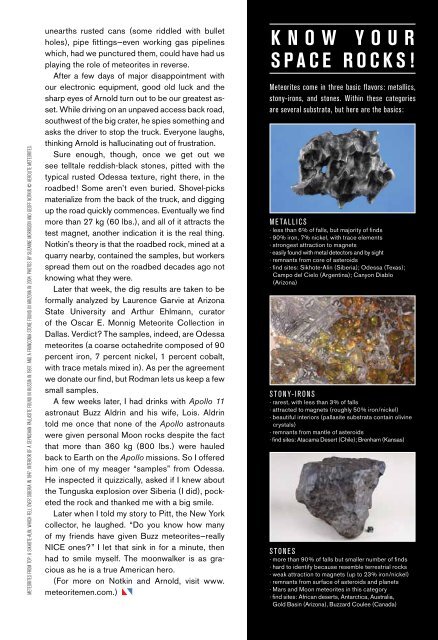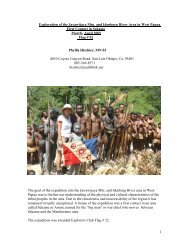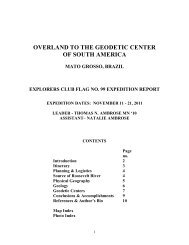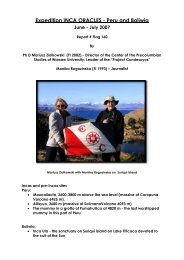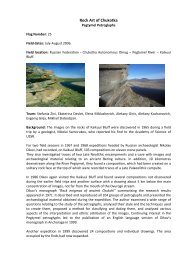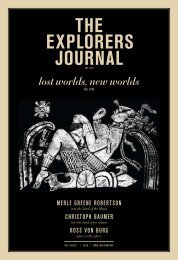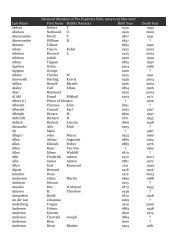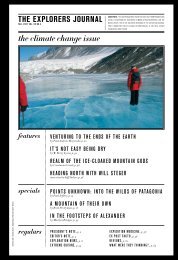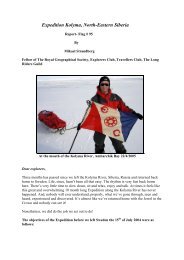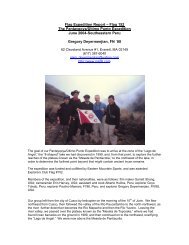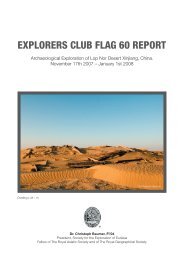the explorers journal - The Explorers Club
the explorers journal - The Explorers Club
the explorers journal - The Explorers Club
You also want an ePaper? Increase the reach of your titles
YUMPU automatically turns print PDFs into web optimized ePapers that Google loves.
meteorites from top: a Sikhote-Alin, which fell over Siberia in 1947; interior of a Seymchan pallasite found in Russia in 1967; and a Franconia stone found in Arizona in 2004. Photos by Suzanne Morrison and Geoff Notkin © Aerolite meteorites.<br />
unearths rusted cans (some riddled with bullet<br />
holes), pipe fittings—even working gas pipelines<br />
which, had we punctured <strong>the</strong>m, could have had us<br />
playing <strong>the</strong> role of meteorites in reverse.<br />
After a few days of major disappointment with<br />
our electronic equipment, good old luck and <strong>the</strong><br />
sharp eyes of Arnold turn out to be our greatest asset.<br />
While driving on an unpaved access back road,<br />
southwest of <strong>the</strong> big crater, he spies something and<br />
asks <strong>the</strong> driver to stop <strong>the</strong> truck. Everyone laughs,<br />
thinking Arnold is hallucinating out of frustration.<br />
Sure enough, though, once we get out we<br />
see telltale reddish-black stones, pitted with <strong>the</strong><br />
typical rusted Odessa texture, right <strong>the</strong>re, in <strong>the</strong><br />
roadbed! Some aren’t even buried. Shovel-picks<br />
materialize from <strong>the</strong> back of <strong>the</strong> truck, and digging<br />
up <strong>the</strong> road quickly commences. Eventually we find<br />
more than 27 kg (60 lbs.), and all of it attracts <strong>the</strong><br />
test magnet, ano<strong>the</strong>r indication it is <strong>the</strong> real thing.<br />
Notkin’s <strong>the</strong>ory is that <strong>the</strong> roadbed rock, mined at a<br />
quarry nearby, contained <strong>the</strong> samples, but workers<br />
spread <strong>the</strong>m out on <strong>the</strong> roadbed decades ago not<br />
knowing what <strong>the</strong>y were.<br />
Later that week, <strong>the</strong> dig results are taken to be<br />
formally analyzed by Laurence Garvie at Arizona<br />
State University and Arthur Ehlmann, curator<br />
of <strong>the</strong> Oscar E. Monnig Meteorite Collection in<br />
Dallas. Verdict <strong>The</strong> samples, indeed, are Odessa<br />
meteorites (a coarse octahedrite composed of 90<br />
percent iron, 7 percent nickel, 1 percent cobalt,<br />
with trace metals mixed in). As per <strong>the</strong> agreement<br />
we donate our find, but Rodman lets us keep a few<br />
small samples.<br />
A few weeks later, I had drinks with Apollo 11<br />
astronaut Buzz Aldrin and his wife, Lois. Aldrin<br />
told me once that none of <strong>the</strong> Apollo astronauts<br />
were given personal Moon rocks despite <strong>the</strong> fact<br />
that more than 360 kg (800 lbs.) were hauled<br />
back to Earth on <strong>the</strong> Apollo missions. So I offered<br />
him one of my meager “samples” from Odessa.<br />
He inspected it quizzically, asked if I knew about<br />
<strong>the</strong> Tunguska explosion over Siberia (I did), pocketed<br />
<strong>the</strong> rock and thanked me with a big smile.<br />
Later when I told my story to Pitt, <strong>the</strong> New York<br />
collector, he laughed. “Do you know how many<br />
of my friends have given Buzz meteorites—really<br />
NICE ones” I let that sink in for a minute, <strong>the</strong>n<br />
had to smile myself. <strong>The</strong> moonwalker is as gracious<br />
as he is a true American hero.<br />
(For more on Notkin and Arnold, visit www.<br />
meteoritemen.com.)<br />
K n o w Y o u r<br />
S p a c e R o c k s !<br />
Meteorites come in three basic flavors: metallics,<br />
stony-irons, and stones. Within <strong>the</strong>se categories<br />
are several substrata, but here are <strong>the</strong> basics:<br />
Me ta l l ics<br />
· less than 6% of falls, but majority of finds<br />
· 90% iron, 7% nickel, with trace elements<br />
· strongest attraction to magnets<br />
· easily found with metal detectors and by sight<br />
· remnants from core of asteroids<br />
· find sites: Sikhote-Alin (Siberia); Odessa (Texas);<br />
Campo del Cielo (Argentina); Canyon Diablo<br />
(Arizona)<br />
S t on y- Irons<br />
· rarest, with less than 3% of falls<br />
· attracted to magnets (roughly 50% iron/nickel)<br />
· beautiful interiors (pallasite substrata contain olivine<br />
crystals)<br />
· remnants from mantle of asteroids<br />
· find sites: Atacama Desert (Chile); Brenham (Kansas)<br />
S t ones<br />
· more than 90% of falls but smaller number of finds<br />
· hard to identify because resemble terrestrial rocks<br />
· weak attraction to magnets (up to 23% iron/nickel)<br />
· remnants from surface of asteroids and planets<br />
· Mars and Moon meteorites in this category<br />
· find sites: African deserts, Antarctica, Australia,<br />
Gold Basin (Arizona), Buzzard Coulee (Canada)


